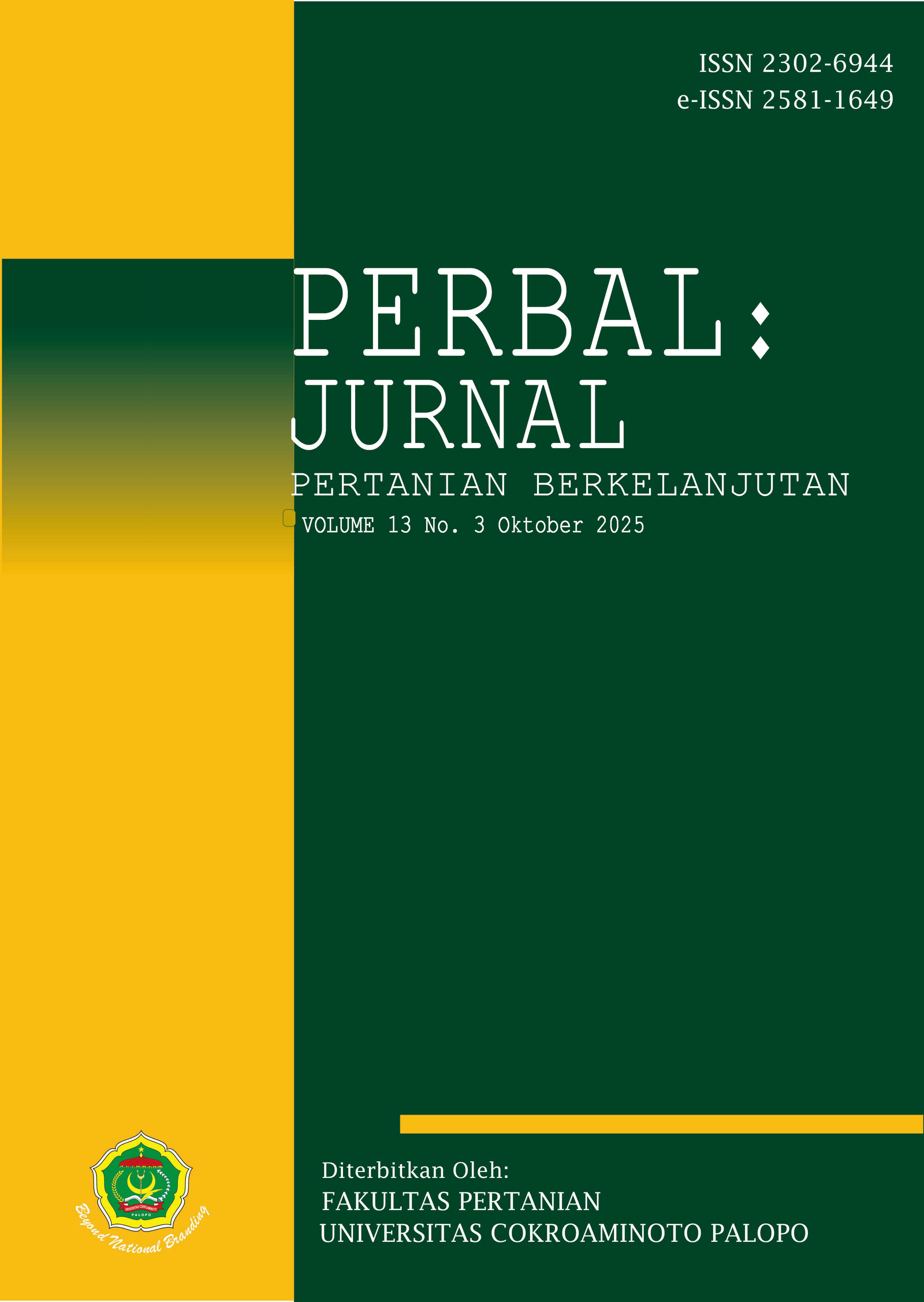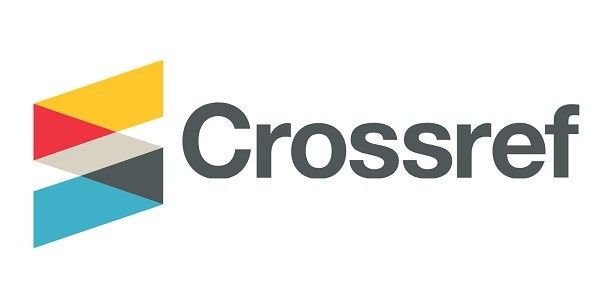Estimasi Cadangan Karbon Tanah Kelapa Sawit Fase Tanaman Menghasilkan pada Lahan Sawah Tadah Hujan Perkebunan Rakyat di Desa Tanjung Rejo Kecamatan Percut Sei Tuan
Estimation of Soil Carbon Stocks of Oil Palm Plantations in the Plant Produce Phase in Rainfed Rice Fields of Smallholder Plantations in TanjungRejo Village Percut Sei Tuan District
DOI:
https://doi.org/10.30605/perbal.v13i3.7024Keywords:
Kelapa sawit, monokultur, polikultur, tadah hujanAbstract
Salah satu tanaman yang kemampuan dalam menyerap CO2 adalah tanaman kelapa sawit, sehingga penananaman kelapa sawit dapat menetralisir konsentrasi CO2 yang terbentuk pada udara yang disebabkan oleh efek rumah kaca yang telah membuat terjadinya perubahan iklim. Penanaman kelapa sawit sudah banyak dilakukan diberbagai tipe lahan termasuk tipe lahan tadah hujan. Masalah yang terjadi penggunaan lahan tadah hujan yaitu tingginya kadar garam, kandungan air tanah yang tinggi, kandungan unsure hara yang rendah serta pH tanah yang masam yang membuat perlunya dilakukan pengelolaan yang tepat agar tanaman dapat menghasilkan pertumbuhan dan produksi yang tinggi. Penelitian dilakukan mengetahui perkiraan cadangan karbon tanah kelapa sawit fase tanaman menghasilkan (TM) pada lahan sawah tadah hujan Perkebunan Rakyat Sungai Dua Dusun XII Desa Tanjung Rejo Kecamatan Percut Sei Tuan. Data dianalisis melalui pemaparan data-data yang diperoleh dari lapangan. Dari hasil penelitian yang dilakukan dapat diketahui bahwa kandungan C-organik pada tanah tadah hujan Perkebunan Rakyat Sungai Dua Dusun XII, pada sistem polikultur sebesar 4,82 g/cm dan pada sistem monokultur sebesar 4,43 g/cm. Kelapa sawit yang ditanam secara polikultur memiliki sifat fisik dan kimia tanah yang lebih baik dibanding sistem tanam monokultur.
Oil palms are a potential crop with a high CO2 absorption capacity, which is very useful in reducing CO2 concentrations in the atmosphere due to the increase in greenhouse gases that cause climate change on Earth. Oil palm cultivation has been widely practiced in rainfed rice fields. Problems often encountered in utilizing rainfed rice fields include excess water, high salinity, low pH, and low nutrient content, requiring proper management to achieve high growth and production. This study aimed to determine the estimated soil carbon stocks of oil palm plantations in the plant produce phase in rainfed rice fields of Sungai Dua Dusun XII smallholder plantations in Tanjung Rejo Village, Percut Sei Tuan District. Data is analyzed through the presentation of average data obtained in the field. From the result of the research conducted, it can be seen that the organic c-content in the rain-fed soil of smallholder plantations in Tanjung Rejo Village, Percut Sei Tuan District, under monoculture systems is 1.62% and under polyculture systems it is 2.25%. Oil palm planted in polyculture have better physical and chemical soil properties than monoculture.
Downloads
References
Alfaredzi, R., Syakur, S., & Khairullah, K. (2023). Evaluasi Sifat Fisika Tanah pada Penggunaan Lahan Monokultur dan Polikultur di Kecamatan Labuhan Haji Kabupaten Aceh Selatan. Jurnal Ilmiah Mahasiswa Pertanian, 8(1), 369-374. DOI: https://doi.org/10.17969/jimfp.v8i1.23043
Anggraini, S. (2022). Pendugaan cadangan karbon kelapa sawit pada kelas umur tanama dewasa dan tua pada lahan tanam. Agritech, 24(1). DOI: https://doi.org/10.30595/agritech.v24i1.9173
Anggraini, S., & Afriyanti, N. (2019). Estimasi cadangan karbon kelapa sawit bibit bersertifikat pada perkebunan kelapa sawit Kabupaten Serdang Bedagai Sumatera Utara. Agroprimatech, 3(1): 11-16. DOI: https://doi.org/10.34012/agroprimatech.v3i2.918
Anggraini, S., & Arifin, Y.W. (2021). Analysis of palm oil carbon stock generating plant phase (TM <20 Years) in silk land with 40-60 cm. Agritepa, 8(1), 1–8. DOI: https://doi.org/10.37676/agritepa.v8i1.1290
Benauli, A. (2021). Kajian status hara N, P, K tanah pada sawah tadah hujan (studi kasus tiga desa di Kecamatan Beringin). Agrosains, 23(1), 55-59. DOI: https://doi.org/10.20961/agsjpa.v23i1.49239
Firmansyah, M.A. (2017). Karakterisasi, kesesuaian lahan dan teknologi kelapa sawit rakyat di rawa Kalimantan Tengah. Jurnal Penelitian Pertanian Terapan, 14(2), 97–105. DOI: https://doi.org/10.25181/jppt.v14i2.147
Hardjowigeno, S. (2012). Evaluasi Kesesuaian Lahan dan Perancangan Tataguna Lahan. Gadjah Mada University Press. Yogyakarta.
Hidayat, T., Rahman, A., & Sari, R.D. (2022). Impact of soil fertility on oil palm yield in smallholder farms. Indonesian Journal of Agricultural Research,10(2), 78–89.
Karuru, S.S., Hadija & Galla, E.A. (2024). Analisis keterkaitan sifat tanah dengan kandungan karbon pada tanah hutan sekunder, kelapa sawit, agroforestri dan sawah di Kabupaten Luwu Timur. Jurnal Eboni, 6(1), 12-21. DOI: https://doi.org/10.46918/eboni.v6i1.2423
Komul, Y.D., dan Hitipeuw, J.C. (2022). Estimasi biomassa karbon serasah dan tanah pada Hutan Negeri Soya Kota Ambon. Jurnal Kehutanan Papuasia, 8(2), 234–240. DOI: https://doi.org/10.46703/jurnalpapuasia.Vol8.Iss2.352
Masganti. (2011). Kesuburan Tanah dan Pemupukan. Medan: USU Press.
Mulyani, A.S. (2021). Pemanasan global, penyebab, dampak dan antisipasinya. Artikel Pengabdian Masyarakat, 1–27.
Pranoto, E., & Wulansari, R. (2018). Kajian monokultur dan tumpangsari tanaman teh dengan cabai di beberapa kemiringan lereng terhadap perubahan pH tanah dan Ca-dd. Jurnal Penelitian Teh dan Kina, 21(2), 65-73. DOI: https://doi.org/10.22302/pptk.jur.jptk.v21i2.148
Sufardi, Martunis, L., & Muyassir. (2017). Pertukaran kation pada beberapa jenis tanah di lahan kering Kabupaten Aceh Besar Provinsi Aceh. Prosiding Seminar Nasional Pascasarjana (SNP) Unsyah, A45-A53.
Susilawati, A., Nursyamsi, D., & Syakir, M. (2016). Optimalisasi penggunaan lahan rawa pasang surut mendukung swasembada pangan nasional. Jurnal Sumberdaya Lahan,10(1), 51–64.
Syahputra, N., Mawardati, & Suryadi. (2017). Analisis faktor yang mempengaruhi petani memilih pola tanam pada tanaman perkebunan di Desa Paya Palas, Kecamatan Ranto Peureulak, Kabupaten Aceh Singkil. Jurnal Agrifo, 2(1). DOI: https://doi.org/10.29103/ag.v2i1.313
Yusuf, W.A., Hasbianto, A., Husaini, M., dan Sosiawan, H. (2024). Kajian kelayakan usahatani sawit rakyat di berbagai tipe luapan lahan rawa pasang surut. Jurnal Triton, 15(2), 326–343. DOI: https://doi.org/10.47687/jt.v15i2.761
Downloads
Published
Issue
Section
License
Copyright (c) 2025 Sari Anggraini

This work is licensed under a Creative Commons Attribution 4.0 International License.
In submitting the manuscript to the journal, the authors certify that:
- They are authorized by their co-authors to enter into these arrangements.
- The work described has not been formally published before, except in the form of an abstract or as part of a published lecture, review, thesis, or overlay journal.
- That it is not under consideration for publication elsewhere,
- That its publication has been approved by all the author(s) and by the responsible authorities – tacitly or explicitly – of the institutes where the work has been carried out.
- They secure the right to reproduce any material that has already been published or copyrighted elsewhere.
- They agree to the following license and copyright agreement.
License and Copyright Agreement
Authors who publish with Onoma Journal: Education, Languages??, and Literature agree to the following terms:
- Authors retain copyright and grant the journal right of first publication with the work simultaneously licensed under Creative Commons Attribution License (CC BY 4.0) that allows others to share the work with an acknowledgment of the work's authorship and initial publication in this journal.
- Authors are able to enter into separate, additional contractual arrangements for the non-exclusive distribution of the journal's published version of the work (e.g., post it to an institutional repository or publish it in a book), with an acknowledgment of its initial publication in this journal.
- Authors are permitted and encouraged to post their work online (e.g., in institutional repositories or on their website) prior to and during the submission process, as it can lead to productive exchanges, as well as earlier and greater citation of published work.














